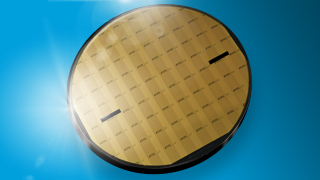GaN On!
September 26, 2016
With the frenzied, fall trade show season in full swing, it helps to have a “GaN-do” attitude. Gallium nitride (GaN) is a semiconductor technology with high current, high voltage capabilities for power-hungry RF systems that comes in many flavors.
 How many? Let's count them up:
How many? Let's count them up:
- GaN-on-silicon or GaN-on-Si,
- GaN-on-silicon carbide or GaN-on-SiC,
- GaN-on-diamond,
- GaN-on-sapphire,
- GaN-on-insulator,
- GaN-on-GaN (not making that up),
- GaN-on-rye (okay, making that up),
And my hyphenated favorite:
- GaN-on-hexagonal boron nitride or GaN-on-h-BN.
Not only is it impossible to write about GaN without wearing out the hyphen key, you can’t
even define GaN without a hyphen. After all, it’s a wide-bandgap or III-V
semiconductor!
Even the applications for GaN are hyphenated:
- Smart-grid,
- Hybrid-electric cars,
- DC-DC converters,
- Point-to-point infrastructure,
- High-reliability networking,
- Battery-operated appliances,
- Field-effect transistors (FET) …
You can see why some companies view GaN as a win-win.
GaN-on-Si vs. GaN-on-SiC
Any which way you GaN, the promise of high power density remains — though some flavors are better than others. The merits of GaN-on-Si vs. GaN-on-SiC are hotly debated within the GaN community, as competing factions argue which technology is superior.
 Ironically, heat is one of the keys to the debate. GaN is likely to be used in applications
that require high output power and, therefore, generate an excessive amount of heat. To ensure
optimal performance and longevity, some GaN devices require an efficient path to remove heat
from the active device surface. At Qorvo, we believe in the excellent thermal properties of
silicon carbide (SiC) to act as the thermal path. As noted in our GaN RF Technology For
Dummies® book:
Ironically, heat is one of the keys to the debate. GaN is likely to be used in applications
that require high output power and, therefore, generate an excessive amount of heat. To ensure
optimal performance and longevity, some GaN devices require an efficient path to remove heat
from the active device surface. At Qorvo, we believe in the excellent thermal properties of
silicon carbide (SiC) to act as the thermal path. As noted in our GaN RF Technology For
Dummies® book:
"GaN is usually grown at a high temperature … on a foreign substrate (SiC for RF applications or Si for power electronics applications). The GaN-on-SiC approach combines the high power density capabilities of GaN with the superior thermal conductivity and low RF losses of SiC. That's why GaN-on-SiC is the combination of choice for high power density RF performance."
GaN-on-SiC devices are also better equipped to withstand harsh environments on land, in the air and at sea. RF power densities for GaN-on-SiC are 5 to 6x higher than gallium arsenide (GaAs)-based RF amplifiers. Its proven ability makes it ideal for infrastructure, defense and aerospace applications such as radar, electronic warfare, communications, navigation and similar uses. GaN-on-SiC gives customers the flexibility to reduce board space and system costs while improving system performance.
Looking to the future, GaN-on-SiC is very well positioned to support the rollout of next-generation wireless networks, but GaN-on-Si isn’t out of the question. The choice will come down to the power density required and cost. Though neither camp is yielding, the volume production proven GaN-on-SiC approaches typically allow for high power density in a smaller package. As we move toward 5G, GaN-on-SiC is the fastest way to get there.
GaN-on-Si, GaN-on-SiC …
"Can’t we all just GaN along," you ask?
We say, "GaN on!" May the best GaN win.
This article first appeared in Brent's Musings on Microwave Journal.
Have another topic that you would like Qorvo experts to cover? Email your suggestions to the Qorvo Blog team and it could be featured in an upcoming post. Please include your contact information in the body of the email.
